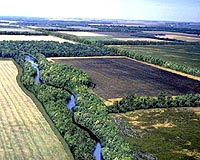| . |  |
. |
Ithaca NY (SPX) May 22, 2009 In the developing fetus, cell growth follows a very specific schedule. In the eye's retina, for example, cones - which help distinguish color during the day - develop before the more light-sensitive rods - which are needed for night vision. But minor differences in the timing of cell proliferation can explain the large differences found in the eyes of two species - owl monkeys and capuchin monkeys - that evolved from a common ancestor. Researchers from Cornell, St. Jude's Children's Research Hospital in Tennessee and the Federal University of Para, Brazil, have found an evolutionary mechanism that provides insight into how important changes in brain structure of primates can evolve. That evolution appears to proceed via simple genetic changes that affect the timing of development of brain regions, they report in a paper published May 18 online and in a future print issue of Proceedings of the National Academy of Sciences. In both monkey species, the specialized eye cells develop in the growing embryo from a single retinal progenitor cell. In their basic design, the eyes of these primates have the capability and necessary architecture to be either nocturnal or diurnal, based on a species' ecological niche and needs, said Cornell neurobiologist and psychologist Barbara Finlay. Finlay and her colleagues compared the developing eyes in fetuses of the two species to better understand how the nocturnal owl monkeys developed retinas with many more rod cells than cones, while capuchin monkeys, which are active during the day (diurnal), developed more cone cells than rods. "These two species evolved about 15 million years ago from a common ancestor that had a diurnal eye," said Finlay, a Cornell professor of psychology and senior author of the paper. "So we believed that comparing how their eyes develop during embryonic growth could help us understand what evolutionary changes would be required to evolve from a diurnal to a nocturnal eye," said Finlay. By comparing the timing of retinal cell proliferation in the two species, the researchers found evidence that an extended period of progenitor cell proliferation in the owl monkey gave rise to an increased number of rod and other associated cells that make its eyes adept at night vision; the eyes also evolved to be large, with bigger light-gathering and light-sensing structures needed for nocturnal sight. "The beauty of the evolutionary mechanism we have identified is that it enables the eye to almost toggle back and forth between a nocturnal and a diurnal structure," said neurobiologist Michael Dyer of St. Jude's hospital. "It is an elegant system that gives the eye a lot of flexibility in terms of specialization." This research was funded by the National Science Foundation and Brazil's NSF equivalent, National Counsel of Technological and Scientific Development. Share This Article With Planet Earth
Related Links Cornell Darwin Today At TerraDaily.com
 Beneficial Plant Spillover Effect Seen From Landscape Corridors
Beneficial Plant Spillover Effect Seen From Landscape CorridorsRaleigh NC (SPX) May 22, 2009 Research by a North Carolina State University biologist and colleagues shows that using landscape corridors, the "superhighways" that connect isolated patches of habitat, to protect certain plants has a large "spillover" effect that increases the number of plant species outside the conservation area. The study found that corridors caused such a wide range of "spillover" beyond the patches ... read more |
|
| The content herein, unless otherwise known to be public domain, are Copyright 1995-2009 - SpaceDaily. AFP and UPI Wire Stories are copyright Agence France-Presse and United Press International. ESA Portal Reports are copyright European Space Agency. All NASA sourced material is public domain. Additional copyrights may apply in whole or part to other bona fide parties. Advertising does not imply endorsement,agreement or approval of any opinions, statements or information provided by SpaceDaily on any Web page published or hosted by SpaceDaily. Privacy Statement |